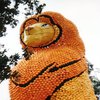Designing Disney’s Hotel Santa Fe
“The most complex story told at Disneyland Paris”
Of all the hotels at Disneyland Paris, Hotel Santa Fe is the one that has been criticized the most by fans as well as visitors. It is often referred to as a banal concrete landscape with parking lots dotting the entire property. According to many, the hotel lacks the theming of the other Disneyland Paris resorts. Additionally, the low level of maintenance of Hotel Santa Fe adds to the overall negative perception.

This essay aims to shed a different, more positive light on Hotel Santa Fe and to appreciate it as an outstanding piece of subtly themed architecture. To me, it is the most captivating and story-telling hotel of all, because it is less obvious in its themed symbolism. Its courtyards are a great place to linger on a hot and sunshine-drenched afternoon, while everybody else is at the parks…

Hotel Santa Fe was designed by mister Antoine Predock. Predock is a so-called site-specific architect. This means that his designs correspond with and evolve from the surroundings for which they are created. So, working on a hotel for the Euro Disney Resort presented him with a huge challenge: the site was a white canvas, a clean slate. Nothing was there he could relate to. It was an empty site for his imagination.

Predock recalls: “The notion of ‘theming’ a building in France was dangerous. How literal could it be? How nostalgic should it be? Should it be there at all? I wanted to project a vision of the West that surrounds me everyday: a site of imagination. I thought the project should be like a Wim Wenders movie, like ‘Paris, Texas’, rather then having the sweetness and nostalgia of Santa Fe.” Hotel Santa Fe was designed to become a canvas for the imagination of guests staying there.


This collage nicely sums up the main ideas for the hotel. One can easily identify many elements of the final design: the yellow line, the UFO, the fauna, the cinema, the adobe architecture and much more. Predock created this collage to present his concept to mister Michael Eisner. Eisner was immediately thrilled. The collage was so huge that they looked at it and discussed it on the lawn of Eisner's Malibu home.


Predock’s design provided for a commons building (which is positioned under a drive-in movie screen featuring the portrait of Clint Eastwood's 'Man with no name' character from Sergio Leone's "Dollars Trilogy”), 49 adobe-style pueblos and a children’s playground. As there was no landscape that he could relate to, Predock had to create one. The pueblos at the border of the Rio Grande river are much taller then the ones close to the commons buildings and due to this, can serve as a backdrop for the hotel.

Predock organized the pueblos along five trails to spark the imagination of the guests: “The hotel has a series of trails as an organizational system. Each trail departs from the horizontal commons building. The trails create a matrix of events and a series of explorations that are particularly oriented to children. The exploration takes place in an architecture that is specific to France in terms of wind protection and sunny exposure.” The courtyards along the trails each create a micro-climate.

The Trail of Infinite Space
“The Trail of Infinite Space portrays the expansiveness of the Western terrain mirroring the infinity of the sky above; the edge between them, the horizon, is ever visible and unattainable.” The trail is marked by a yellow line that begins in the hotel’s front parking lot. It “recalls the never-ending yellow line of the great American highway.”

“The first element of trail is the drive-in movie screen over the commons building, which is centered on an actual yellow line. Originally, the screen was a tabula rasa, an empty plane onto which one could project its fantasies, but [while Eisner didn’t like the idea of an empty screen] eventually an image of Clint Eastwood was chosen.”
Predock continues: “The yellow line leads on, the hotel seems to converge around it, exaggerating the feeling of infinite space. At the end of the trail is a stainless-steel disk. Resembling a UFO, the disk slices into the ground, interrupting the trail.” The line marks the central axis of the hotel.

The so-called commons building is a strikingly simple – and thereby authentic – structure. This is exactly the kind of functional building one could find along highways through the desert. No fuss, little decoration. The interior of the commons building is almost in its original 1992 state and leans heavily on Route 66 and Native American designs.
An attractive and often overlooked feature of this building is the observation deck. It is a rotunda, which connects the restaurant and bar with the children’s’ playground on the other side of the complex. The playground resembles "ruins" of an ancient Anasazi village and is the most beautiful playground of the entire resort.

The Trail of Water
The Trail of Water (symbolized by a fish) reminds us of the importance of water in the dessert. Building 33, the tallest of the hotel’s 49 adobe-style pueblos, is the highlight of the trail. The structure features a stunning water cascade.

“At one point the water dives down a one-hundred-foot course. When it reaches ground level, it is discharged in two directions. One channel is geometrically ordered. Almost like an irrigation canal, it traverses a series of courtyards interrupted by a triangular fishpond and the dance of sprinklers [that can be found next to building 30]. The other channel is naturalistic. The water travels along a rocky stream bed until it reaches a geothermal event: stream issuing from the rocks.”

“The Trail of Water suggests geothermal activity, desert mirages, intense irrigation, mountain streams and suburban lawn sprinklers”.
The Trail of Artifacts
The Trail of Artifacts is about objects left behind in the dessert. It “hints the remnants not only of ancient settlements and historical events, but also of modern habitation, industrial development, and tourism.” The trail is symbolized by a snake (that can be found next to building 18).

It is “organized along a path of broken aquamarine tiles inspired by the favorite turquoise-inlay belt buckle of [the architect]. One artifact is a caged fake saguaro cactus: ‘saguaro in bondage’ [that can be found between buildings 10 and 18]. Also along the trail is a collection of rusting cars. [The architect] found them in parts on North Fourth Street in Albuquerque: a 1932 Plymouth, a 1946 Chevy pickup and a 1957 Ford Fairlane.”

“All cars were packed into containers, shipped to Houston, and then to France, where they were embedded into a courtyard [formerly located between buildings 12 and 15], suggesting the erosion and deterioration of the desert. Crashing into the top of a building at the end of the trail is a fiberglass meteorite. These icons of the desert are just as interesting and ubiquitous as the adobe ruins [of the playground].”

The Trail of Monument Valley
The Trail of Monument Valley (also called ‘The Trail of Monuments’) “refers to spectacular geologic formations astride an endless plain.”

The pueblos along this trail “contain dislodged fragments of buildings, some axially rotated [for example on top of building 46]. Here [Predock] was influenced by the reassembled landscapes of the ‘Road Runner’ and ‘Krazy Kat’ cartoons. I wanted to include something of the way those cartoons used impossibly balancing rocks to signify the existence of a fantasy realm.” A neon roadrunner can be found at the beginning of the trail.


The Trail of Legends
Finally, there is the Trail of Legends, symbolized by a white buffalo. This trail pays tribute to the “legends derived from the act of taming both people and environments [in the Southwest] and the larger-than-life characters who carried out that doctrine.”

The trail “begins with a volcano [that can be found next to building 58] and four archetypal Western buildings [55, 56, 57, 58], all containing guest rooms: a gold metallic block suggests the gold rush; a silver metallic block, coins or a bank; a raw concrete block, a jail and a red block, a bordello. A black and white building [50] is deformed, set at an angle. It is a dissonant piece that recalls the black hat/white hat myths of the West – the tension between good and evil.”

Hotel Santa Fe is far more complex and ambivalent in its message than the other hotels of the resort. In fact, Hotel Santa Fe has many individual stories to tell. These stories are often not easy to understand. But they are all beautiful and meaningful in a very special way.

I had the chance to wander the grounds of this magnificent place on a hot and sunny afternoon last summer. It seemed as if nobody else was there, except for a few staff members.

I walked each trail, took photos and looked at the various objects Predock placed throughout the property. I climbed the concrete snake and the “mountain” from which water cascades down into the valley. I admired the gold and silver buildings that looked amazing in the bright sunlight.

The place was tranquil and mysterious, yet familiar…
According to “InsideDLParis” on Twitter, Hotel Santa Fe will be completely refurbished by Summer 2013. During its renovation, all trails / the original theme will be removed and the hotel will be taken over by the characters of Disney / Pixar’s “Cars”.

So there’s no more time to waste. Stay at “the original” Hotel Santa Fe and discover its five fascinating trails, before it’s too late! After all, the original Hotel Santa Fe is a hidden gem that will surely amaze anyone who loves architecture!

This article was written by Will . His fascination and appreciation for Disney started with the opening of Euro Disneyland in 1992. Coming from an American Cultural Studies background, Will today is most interested in the original concept of the Euro Disney Resort and the cultural messages that the Walt Disney Company wanted to convey about the United States back in the late 1980s. To Will, the 1992 Euro Disney complex is an outstanding example of postmodern architecture and culture, which should be maintained in and reconstructed to its original state as closely as possible. These concerns and interests lead the author to follow and support 'Designing Disney'. We thank Will for the effort he made.

Credits
Photos:
- Nr 15 & 17: Christoper Davey
- Nr 28: Gerard Stolk

















